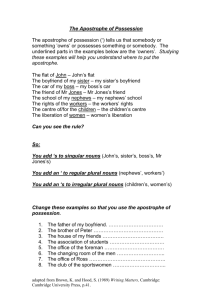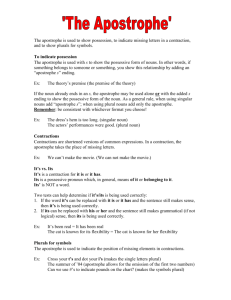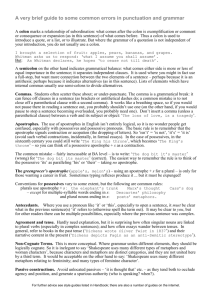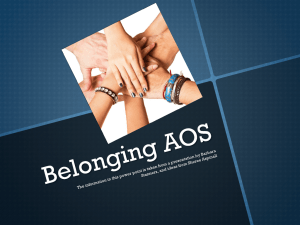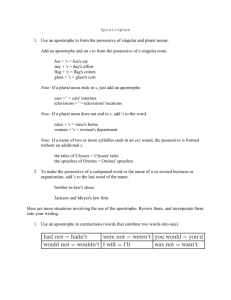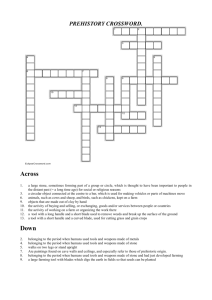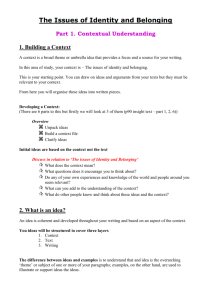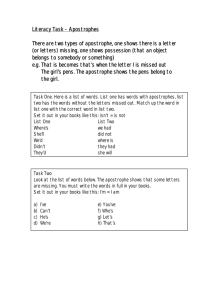Apostrophe - Oxford Learning Institute
advertisement
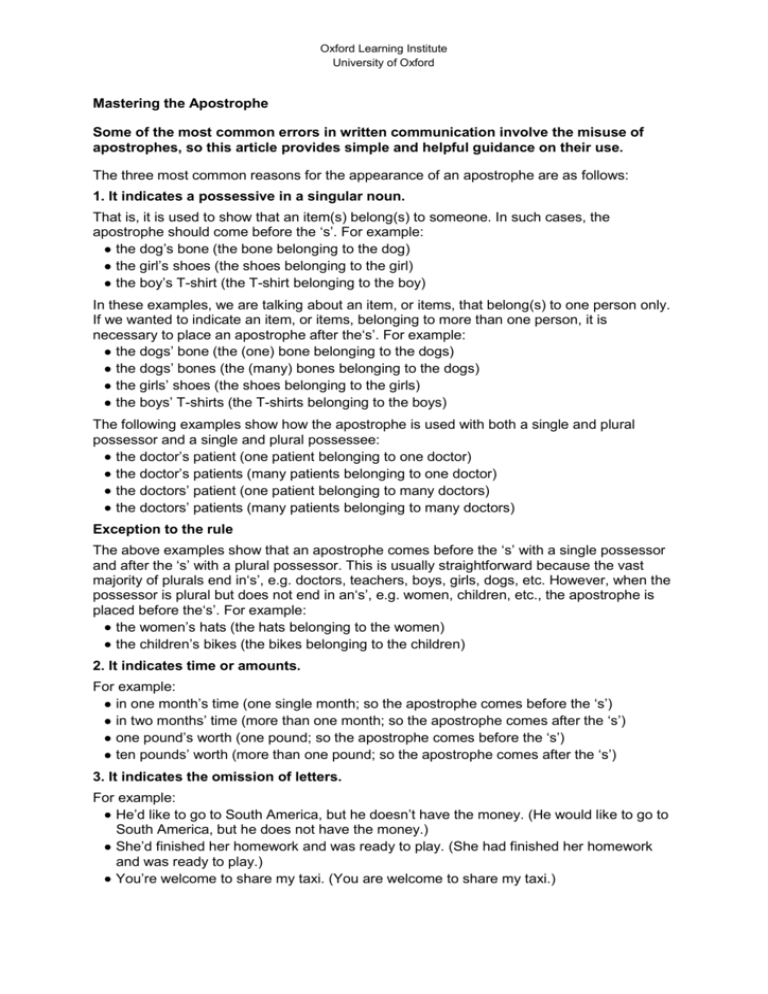
Oxford Learning Institute University of Oxford Mastering the Apostrophe Some of the most common errors in written communication involve the misuse of apostrophes, so this article provides simple and helpful guidance on their use. The three most common reasons for the appearance of an apostrophe are as follows: 1. It indicates a possessive in a singular noun. That is, it is used to show that an item(s) belong(s) to someone. In such cases, the apostrophe should come before the ‘s’. For example: the dog’s bone (the bone belonging to the dog) the girl’s shoes (the shoes belonging to the girl) the boy’s T-shirt (the T-shirt belonging to the boy) In these examples, we are talking about an item, or items, that belong(s) to one person only. If we wanted to indicate an item, or items, belonging to more than one person, it is necessary to place an apostrophe after the‘s’. For example: the dogs’ bone (the (one) bone belonging to the dogs) the dogs’ bones (the (many) bones belonging to the dogs) the girls’ shoes (the shoes belonging to the girls) the boys’ T-shirts (the T-shirts belonging to the boys) The following examples show how the apostrophe is used with both a single and plural possessor and a single and plural possessee: the doctor’s patient (one patient belonging to one doctor) the doctor’s patients (many patients belonging to one doctor) the doctors’ patient (one patient belonging to many doctors) the doctors’ patients (many patients belonging to many doctors) Exception to the rule The above examples show that an apostrophe comes before the ‘s’ with a single possessor and after the ‘s’ with a plural possessor. This is usually straightforward because the vast majority of plurals end in‘s’, e.g. doctors, teachers, boys, girls, dogs, etc. However, when the possessor is plural but does not end in an‘s’, e.g. women, children, etc., the apostrophe is placed before the‘s’. For example: the women’s hats (the hats belonging to the women) the children’s bikes (the bikes belonging to the children) 2. It indicates time or amounts. For example: in one month’s time (one single month; so the apostrophe comes before the ‘s’) in two months’ time (more than one month; so the apostrophe comes after the ‘s’) one pound’s worth (one pound; so the apostrophe comes before the ‘s’) ten pounds’ worth (more than one pound; so the apostrophe comes after the ‘s’) 3. It indicates the omission of letters. For example: He’d like to go to South America, but he doesn’t have the money. (He would like to go to South America, but he does not have the money.) She’d finished her homework and was ready to play. (She had finished her homework and was ready to play.) You’re welcome to share my taxi. (You are welcome to share my taxi.) Oxford Learning Institute University of Oxford The most common example of the apostrophe signalling missing letters is with the word ‘it’s’. Here, the rule is that the word ‘it’s’ (with one apostrophe before the‘s’) means ‘it is’ or ‘it has’. For example: it’s raining (it is raining) it’s mine (it is mine) it’s been ages since I saw him (it has been ages since I saw him) If the word does not mean ‘it is’ or ‘it has’, you must use ‘its’ (with no apostrophe). ‘Its’ is used to denote possession. For example: the dog guarded its bone the national library was highly regarded for its collection of books the Golf Association welcomes you to its annual ball General rule If you can replace the word with 'it is' or 'it has', it's OK to use 'it's'. If you can't, then use 'its'. There is never a plural after the’s’ in 'its' because 'it is' always refers to singular possession. Other common errors concerning the great ‘missing letters versus possession’ debate are outlined in the examples below. You’re versus your ‘You’re’ means ‘you are’ and has an apostrophe to indicate a missing letter (in this case, the letter ‘a’). For example: You’re great! (You are great!) ‘Your’ indicates possession and means ‘belonging to you’. An example of using this is: Your coat is hanging up. (The coat belonging to you is hanging up.) They’re versus their They’re means ‘they are’ and has an apostrophe to indicate a missing letter (again, the letter ‘a’). For example: They’re expecting you. (They are expecting you.) ‘Their’ indicates possession and means ‘belonging to them’. For example: Their house was damaged in the storm. (The house belonging to them was damaged in the storm.) Word Meaning Example Its Belonging to it The cat licked its paws It’s It is or it has It’s raining men / it’s been too long Your Belonging to you Your new shoes You’re You are You’re a dear friend Their Belonging to them Their big, fancy car They’re They are They’re pleased to be here We’re We are We’re going to London Were Past plural of ‘to be’ We were young once

